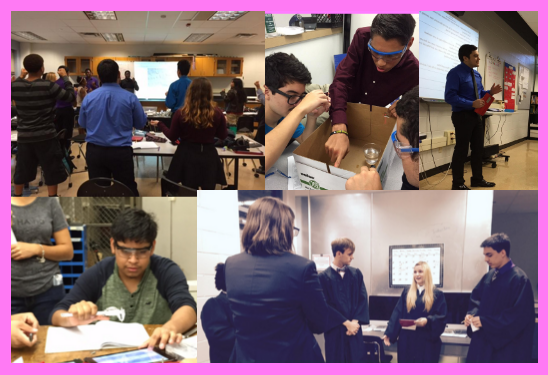


WHERETO Framework: Framework for developing good scaffolding
- W: How will I let students know WHAT they are learning and WHY they are learning it? How will I communicate my expectations for the unit?
- display driving questions, project rubrics, and exemplars in a class bulletin board
- H: How will I HOOK and engage students in their learning? How can I connect student interests to curricular goals?
- start projects with an interesting mystery or challenge
- other HOOKS: counterintuitive phenomena, provocative essential questions, emotional encounters, humor, controversial issues, authentic problems, problems based on student interests
- E: How will I EQUIP students to meet learning goals? What learning EXPERIENCES will deepen their understanding of key ideas?
- use balance of constructivist learning experiences, structured activities and direct instruction. See this article for simple idea for deciding which experiences go with which types of knowledge.
- R: How will I encourage students to RETHINK prior knowledge? And also REFINE and REVISE their work?
- use this R with difficult to understand, counterintuitive content
- techniques: play devil’s advocate, present new info, conduct debates, regular self assessment
- use prompts to encourage self-assessment:
- what are you most proud of? most disappointed in?
- how does your preferred learning style influence … ?
- how will you make use of what you’ve learned?
- for more ideas, see this article
- E: How will we EVALUATE student learning and student work?
- 5 minute paper – what have we concluded? what remains unanswered or unresolved?
- attach self assessment to each product
- 1 minute paper at end of workshop – what was learned? what is confusing?
- train students how to use rubrics to self assess to plan next steps
- start class with burning questions from 1 minute papers and debrief at end of class to check if questions were answered
- T: How can we TAILOR learning activities to match students’ interests, learning profiles and readiness levels?
- See all blog articles under the Differentiation tag
- Use diagnostic and pre-assessments to identify student needs
- Cluster student needs and design scaffolding for these
- Give students some CHOICE in their scaffolding and products
- O: How will learning experiences be ORGANIZED or sequenced?
- Introduce the HOOK early and revisit often
- Teach enabling skills when they are needed to make sense of a problem
- Revisit the WHY often
- Cycle between learning-doing-reflecting
- Cycle between whole-part-whole
- Use 6 facets to design scaffolding that deepens understanding

- W – Communicating end goals and essential questions can help students organize knowledge. Student can better organize their own learning when they are aware of the overarching ideas and goals of the project. Students are more likely to produce high quality work when expectations and models are communicated early in the project.
- H – Engaging topics help students apply knowledge in novel contexts. Education should be an itch, not a scratch.
- E – Building enabling skills in the context of complex tasks will build relevance for those skills and enable students co create better products.
- R – Big ideas need to reconsidered and big understandings must be refined over time.
- E – Building self assessment skills can improve products and develop student independence.
- T – Tailoring to specific learner needs can make learning more accessible to more students. Tailoring to specific interests can make learning more engaging. Identifying and resolving learning gaps can make learners more able to solve complex problems.
- O – Organizing in ways that use cycles gives students opportunities to grasp and re-grasp new material. Resisting the urge to frontload information and reserving instruction for just-in-time moments will create more willing learners.

Preparation Steps
- Use WHERETO framework to design and evaluate scaffolding, assessments, driving questions, and project calendars
- Use WHERETO framework to refine project prior to launching it
Early Implementation Steps
- Implement project – identify, observe and document learning events that fit in the WHERETO framework (or missed the mark)
- Used WHERETO evaluations to finetune scaffolding
Advanced Implementation Steps
- Design and implement a WHERETO graphic organizer that students can use to evaluate projects
- Design and implement a similar WHERETO graphic organizer that students can use to evaluate their own collaboration and project work

- Core beliefs tying curriculum to student diversity
- 4 Assessment practices that honor student differences
- Differentiated instruction articles
- Scaffolding articles
- Assessment articles
- PBL articles
